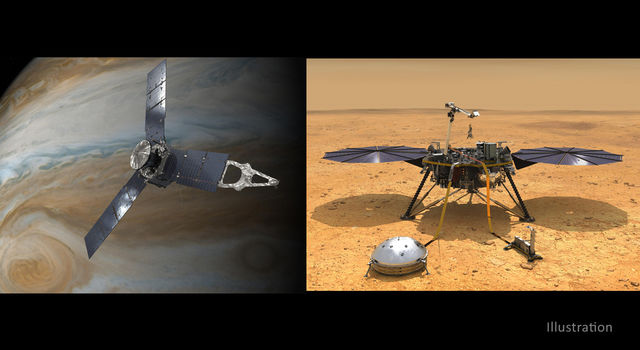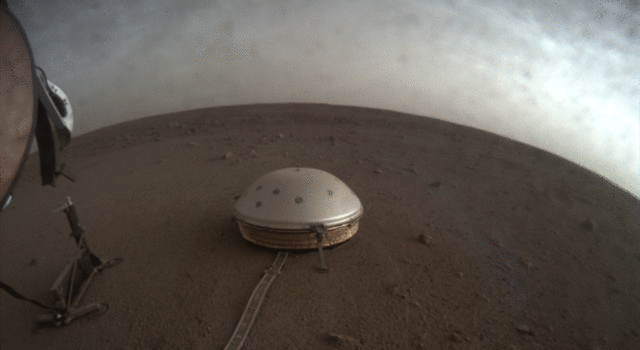Blogs | Dawn Journal | February 29, 2012
Highs and Lows of Exploring the Giant Asteroid
Dear Ups and Dawns,
Dawn is continuing its exploits at Vesta, performing detailed studies of the colossal asteroid from its low altitude mapping orbit (LAMO). The robotic ambassador is operating extremely well on behalf of the creatures it represents on a distant planet. On this second intercalary day of its ambitious adventure, the spacecraft is doing exactly what it was designed to do: exploring a previously uncharted alien world.
Although we usually describe LAMO as being at an average altitude of 210 kilometers (130 miles), that does not mean it is at a constant altitude. As we saw on the fourth anniversary of Dawn's departure from Earth, there are two reasons the spacecraft's height changes. One is that the elevation of the surface itself changes, so if the probe flew in a perfect circle around Vesta, its altitude would vary according to the topography. Like the planet from which Dawn embarked upon its deep space journey in 2007 (and even some of the residents there), Vesta is broadest near its equator, and that is where the ground generally reaches its greatest distance from the center. In addition, the ancient surface, battered over billions of years in the rough and tumble of the asteroid belt, displays remarkable variations in shape. The giant Rheasilvia basin is a scar from an extraordinary impact that excavated a region encompassing the south pole more than 500 kilometers (over 300 miles) in diameter. This immense gouge has left that part of Vesta at a much lower elevation than elsewhere. In the center of the enormous depression is the second tallest mountain known in the solar system, soaring to well over twice the height of Mt. Everest. The vertical range from the highest locations near the equator to the bottoms of the deepest craters within Rheasilvia is more than 60 kilometers (37 miles). So as Dawn loops around in just over four hours, the surface underneath it rises and falls dramatically.
The second reason is that the orbit itself is not exactly a circle. Let's ignore for a moment the effect of the topography and focus solely on the shape of the craft's path around Vesta. As Vesta rotates and Dawn revolves, the gravitational forces acting on the orbiter are always changing because of the irregular distribution of material inside the geologically complex protoplanet. This effect occurred at the higher altitudes as well, but it was much less pronounced there. Now that the adventurer is deep in the gravity field, the peaks and valleys of its own motion are magnified.
Navigators were very careful in choosing the parameters for LAMO, recognizing that the orbital waters were turbulent. Nevertheless, their mapping of the gravitational currents proved quite accurate, and the spacecraft has followed the planned course quite well. The lengthy and relatively technical discussions in the two previous logs described why the ship drifts off a little, but operators occasionally nudge it back with the ion propulsion system.
Orbits usually are best described by ellipses, like flattened circles. Now Vesta's bumpy gravity field does not allow perfectly smooth, regular orbits at low altitude. Moreover, the variations in the strength of the gravitational attraction transform the orbits. Sometimes, the difference between the high point of a loop and the low point is less than 16 kilometers (10 miles). As the changing forces reshape the orbit, the ellipse gets more exaggerated, with the low points going lower and the high points going higher. The differences within one revolution grow to be more than 75 kilometers (47 miles). Thanks to the ingenious design of the orbital trajectory however, those same forces then will gradually attenuate the profile, causing it to become more round again. This pattern repeats every 11.5 days in LAMO. It is almost as if the orbit breathes slowly, its envelope expanding and contracting.
This evolution of the orbit occurs above the rugged shape of Vesta itself. These two effects have conspired so that Dawn has been less than 170 kilometers (106 miles) from the rocky surface on several occasions when it was over equatorial regions. At its greatest altitude in LAMO, Dawn occasionally reaches to more than 290 kilometers (180 miles). This happens when it is deep in the southern hemisphere, soaring over the low elevation terrain of Rheasilvia.
These changes in the distance to the ground were known before Dawn arrived in LAMO, and they do not compromise the ongoing campaign to learn as much as possible about this survivor from the dawn of the solar system. As it revolves around the behemoth beneath it, the spacecraft uses its gamma ray and neutron detector (GRaND) to record these subatomic particles, which carry the signature of the elements within the top meter (yard) of the surface. Navigators' extraordinarily accurate measurements of the ship's orbital motion reveal subtleties in the gravity field and hence the distribution of material throughout the gigantic asteroid. Controllers have taken advantage of the low altitude and smooth operations to collect more observations with the camera and the visible and infrared mapping spectrometer (VIR). More than 7500 pictures have been acquired so far in LAMO, and VIR has returned nearly one million spectra. These provide a fabulous scientific bonus, affording scientists a much more detailed view of Vesta than had been planned with survey orbit and the high altitude mapping orbit (HAMO).
The acquisition of science data was interrupted on February 21 when the main computer was temporarily overloaded with tasks. The system correctly responded by rebooting the computer, which put the spacecraft into safe mode. Because this occurred during a communications session, controllers observed the event (albeit delayed by the long travel time for radio signals to reach Earth). They quickly diagnosed the problem and began the meticulous commanding to bring the robot back its normal configuration. Within a few days, it had resumed its normal schedule of observations.
In some sense, even the GRaND and gravity measurements now are a bonus. When the detailed timeline for Dawn's residence at Vesta was formulated, mission planners allowed 70 days in LAMO, which began on December 12 and so would have concluded on February 20. As we saw at the end of 2011, because the unique approach, the intensive observations in survey orbit and HAMO, and the complex spiral flights from each science orbit to the next have all been accomplished so well (perhaps even unexpectedly well), the 40 days that were held in reserve to overcome problems are now being used to prolong the studies at low altitude. With all sensors fully operational, the robotic explorer is making the best possible use of its precious time at Vesta, revealing more and more exciting details of a mysterious world deep in the asteroid belt.
Dawn is 210 kilometers (130 miles) from Vesta. It is also 3.33 AU (498 million kilometers or 309 million miles) from Earth, or 1240 times as far as the moon and 3.36 times as far as the sun today. Radio signals, traveling at the universal limit of the speed of light, take 55 minutes to make the round trip.
Dr. Marc D. Rayman
8:00 a.m. PST February 29, 2012
TAGS:DAWN, CERES, VESTA, DWARF PLANETS, SOLAR SYSTEM, MISSION, SPACECRAFT







